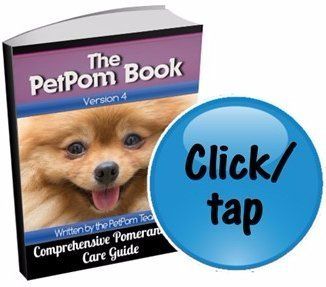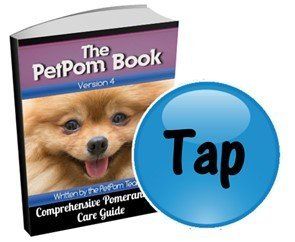Calories
PetPom
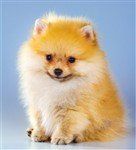
The
Pomeranian
Information
Center
Pomeranian Calorie Needs
Overview
It's common for Pom owners to want to know how many calories a Pomeranian puppy or older dog needs. After all, when we think about what we ourselves eat, particularly those who are trying to eat healthy, we often think in terms of calories. Someone may have the goal to ingest 1800 calories per day instead of thinking in terms of, '3 meals and one snack'.
Another reason why this is such a popular subject is because of the size of the Pomeranian. Most Poms are very tiny (those that don't own Poms are often surprised just how little this toy breed is) with puppies often just 2 to 3 lbs. and many adults only 4 to 7 lbs. and a few are much larger than expected (if over 14 pounds, a Pom may actually be a Throwback).
So, with the majority of owners having super small dogs, it's always on the mind if the puppy or dog is eating enough. Small dogs can seem to struggle to keep up their weight. With the rare, larger Poms, owners want to ensure that it is simply a matter of bone structure and not overeating.
And since either quantity of food and calories are the 2 main ways that food is measured, owners look to find out the exact calorie needs of Pomeranians in an attempt to make sure that their dog is receiving enough nutrients.
To help answer your questions, this section will cover the following:
- Factors that affect caloric needs
- How many calories a Pomeranian needs based on age and activity level
- Calorie comparison of foods (dry vs wet vs homemade)
- Elements that are far more important than calories
- Making adjustments to how much your Pomeranian eats
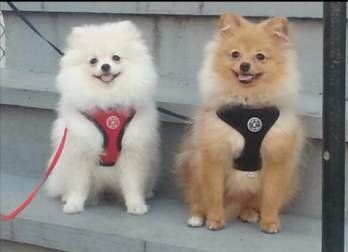

Gidget (7 months) & Gizmo (8 months)
Photo courtesy of Harry & Kathy Torres
3 Factors Affect A Pomeranian's Calorie Requirements
As you can imagine, there is not one blanket answer to calorie requirements. If so, we would give you a number and we'd be onto another subject!
There are 3 main elements that will change how many calories needs to either grow as a puppy or maintain as an adult.
1) Age.
This is one of the biggest factors. Growing puppies burn a lot more calories per pound of body weight than adults. The body needs extra fuel for growth and the metabolism is high.
Essentially every part of the body is under transformation, from the muscles to the bones and everything in between.
One thing to keep in mind is that while Pom puppies are essentially always growing, there are always growth spurts and pauses.
Calorie needs may change from day to day or week to week and for this reason nailing down an exact amount of food to feed the pup is a bit difficult. During rapid growth spurts, a Pom puppy may always seem hungry even if you are feeding him the same. If he's been growing rapidly and has a lull, he may then eat less compared to what he needed during that time.
Adults Poms often do well maintaining, however Pomeranians may be walked less often times of extreme weather (cold winters, hot summers) and this may led to the Pom needing some food adjustments; though many dogs will in turn have less of an appetite during these times.
With seniors (Poms over the age of 8), there will be a gradual slowing of the metabolism. It happens very gradually, so most owners will not notice right away. However, each year it becomes a bit more evident.
A 12 year old Pom will burn fewer calories per day than his 5 year old counterpart and therefore may either needs his calories reduced or on his own, may not eat as much.
2) Activity.
This is also a big influence in how much fuel a dog's body requires. This includes two types of activity:
1. Exercise - This refers to purposeful activity initiated by the owner for a certain duration at which the Pom is either walking briskly or playing a rousing game that requires him to energetically trot, such as fetch.
2. NEAT - This stands for Non-Exercise Activity Thermogenesis. NEAT is all of the little movements throughout the day that burn calories. This includes rising from a down position, walking (or scampering) across the room, jumping up, rolling around, playing with toys, etc.
So, this is not activity that raises a dog's heart rate or can be counted as exercise, however it plays a big role. A calorie burned here and another one burned there can add up to quite a bit by the end of the day.
If you take one Pomeranian that is very mellow (rests all day, stays in one room, etc.) and compared that dog to a Pom that paced a lot when home alone and ran around with tons of energy when owners were home, that second Pomeranian would have a higher calorie requirement to maintain his weight.
It should also be mentioned that spaying and neutering a dog does not in and of itself cause a dog to require less food or to gain weight. This spaying and neutering myth
is most often due to a fixed dog being less active and therefore needing a few less calories each day.
Over a few month or years, this can add up and especially for small dogs like the Pomeranian, just a pound or two can make a big difference.
3) Health Status
- If a Pomeranian has a chronic condition that leads to being less active, his calorie needs will lower slightly and often many Poms adjust due to a decreased appetite. During times of health issues, it is important to keep feeding a very high quality food to give the dog energy, vitamins and nutrients.
Poms that don't feel well often do best with smaller, more frequent meals. Those that are having stomach problems may need to be temporarily moved to bland diet or even a semi-solid diet; owners should talk to their veterinarian about this.
One of the biggest calorie requirement changes will happen is for females that are pregnant and afterward while lactating. During the first 4 weeks, there is not much of a change, just 1.1 times more food than normal.
However, a pregnant Pomeranian will need approximately 1.5 times more calories than normal during weeks 5 and 6. While she is nursing the litter, she will need even more...
Up to 2 times her normal calorie requirements for milk production.
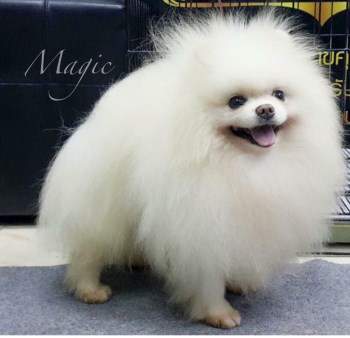

Magic, 1 and 1/2 years old
Photo courtesy of Wilson Buen
Up to 2 times her normal calorie requirements for milk production.
Guidelines of Calorie Needs Based on Age & Weight
We realize that many owners want an exact, specific number. However, we must keep in mind that age, activity and health all play a role. For this reason, there is a range that we can refer to.
Do keep in mind that these figures are for your reference; however there are much more effective methods to ensure that your Pom is eating properly (more ahead).
Growing Pom Puppies
- The guideline for growing puppies is 55 calories per each pound of body weight. This actual number of calories burned each day will vary wildly, due to a puppy's hyperactivity, growth spurt vs rest and more. This number can fluctuate up or down by 20%:
Weight = Calorie Requirement per Day
1 lb. (0.45 kg) = 50
1.5 lbs. (.68 kg) = 80
2 lbs. (0.90 kg) = 100
2.5 lbs. (1.13 kg) = 138
3 lbs. (1.36 kg) = 150
3.5 lbs. (1.58 kg) = 193
4 lbs. (1.81 kg) = 200
4.5 lbs. (2.04 kg) = 248
5 lbs. (2.26 kg) = 250
5.5 lbs. (2.49 kg) = 303
6 lbs. (2.72 kg) = 330
6.5 lbs. (2.94 kg) = 358
7 lbs. (3.17 kg) = 385
***
Please remember that these numbers can go up or down 20%.
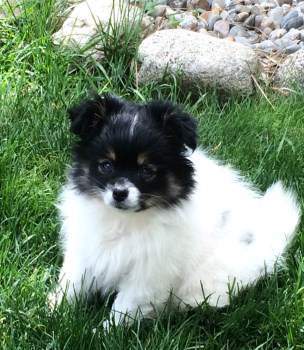
Kenzi, 3 months old
Photo courtesy of Judy Wiley
Adult Pomeranians
- Adult dogs, in general, require approximately 40 calories for each pound of body weight.
However, since age, exercise
level and health play huge roles in this, as well as even things such as NEAT (how much your Pom moves through the day), the number of 40 calories per pound can fluctuate 20% up or down.
Weight = Calorie Requirement per Day
4 lbs. (1.81 kg) = 128 to 192
4.5 lbs. (2.04 kg) = 144 to 216
5 lbs. (2.26 kg) = 160 to 240
5.5 lbs. (2.49 kg) = 176 to 264
6 lbs. (2.72 kg) = 192 to 288
6.5 lbs. (2.94 kg) = 208 to 312
7 lbs. (3.17 kg) = 224 to 336
7.5 lbs. (3.4 kg) = 240 to 360
8 lbs. (3.62 kg) = 256 to 384
8.5 lbs. (3.85 kg) = 272 to 408
9 lbs. (4.08 kg) = 288 to 432
Senior Pomeranians
-In regard to aging, there is never just one day that a dog suddenly needs a change in his diet.
As dogs age, there is a barely perceivable slowing of the metabolism.
Joints may begin to ache and the senior Pom
walks a bit slower. As the dog ages, he may play a bit less and take slightly longer naps. Then one day, you suddenly do notice that there has been a change and you ask "When did that happen?!"
This is not a breed that typically becomes overweight. The majority of Poms do a sort of self-regulation; appetite often decreases as his/her energy needs slow down. So, for this reason, there is no need to be fanatical about food or calories; just do be aware that seniors will eat a bit less than their younger counterparts.
General guidelines for senior dogs, due to a slower metabolism and less exercise- are on the lower end of that for adults; 30 to 40 calories per each pound of body weight.
Weight = Calorie Requirement per Day
4 lbs. (1.81 kg)= 120 to 160
4.5 lbs. (2.04 kg)= 135 to 180
5 lbs. (2.26 kg)= 150 to 200
5.5 lbs. (2.49 kg)= 165 to 220
6 lbs. (2.72 kg)= 180 to 240
6.5 lbs. (2.94 kg)= 195 to 260
7 lbs. (3.17 kg)= 210 to 280
7.5 lbs. (3.4 kg)= 225 to 300
8 lbs. (3.62 kg)= 240 to 320
8.5 lbs. (3.85 kg)= 255 to 340
9 lbs. (4.08 kg)= 270 to 360
The Significance of Calories
When all is said and done, the exact number of calories that a Pomeranian ingests each day is of little importance compared to what he is eating. Curious owners are interested in seeing the numbers; however staying within that range without any regard to other factors is not beneficial to a dog's health.
Much more important questions to ask are… is the Pomeranian eating:
- Fillers - Useless ingredients meant to fluff out food, to make it appear that there is more than there really is. These pass right through the body since there are no nutrients to be absorbed and come right out the other end.
These make a dog feel full for a little while, while offering nothing of real substance.
- Artificial flavoring, coloring and preservatives - All sorts of nasty chemicals can be in cheap commercial food. These chemicals can cause a range of allergies; in the majority of cases, when a dog is allergic to 'food', he is actually allergic to the chemicals found within that food.
- By-products - If this had a different name, more dog owners would never purchase a brand that had this. When an animal is processed, it is separated due to what is considered to be fit for human consumption… and then there is everything else that is left.
And that 'what is left' is given the term of 'by-products'. This includes, but is not limited to: feet, lungs, head (tissue from between the eyes, nasal cavities, throat tissues, etc.), intestines, spleen, spinal cord pieces and reproductive organs.
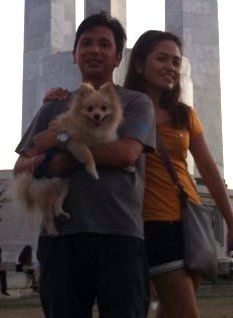
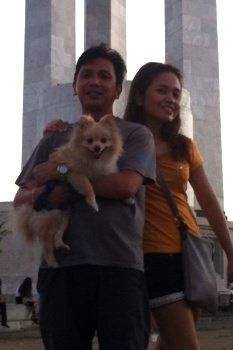
Pompom, 1 year old male
Photo courtesy of Aldwin Ortiz , from Philippines
When dogs are given inferior food, this is the canine equivalent to processed junk food. We encourage all Pomeranian owners to choose their Pom's food
wisely and only offer wholesome, all-natural foods for both main meals and snacks. What your Pom eats right now will not only affect his short-term health, but his long-term health for years to come.
Making Calorie Adjustments
Puppies - From birth to 6 months, growth is rapid. With 8 week old
Pomeranian puppies, there can be weight gain each day. Up until 6 months or so, there should be small gains (and some bigger spurts) each week.
This slows by the half year mark, however most Poms will keep growing in a noticeable way to the 9 month mark and then become just a tad larger up until the 1 year mark.
If your Pom ever loses weight during this time or if there is a period of time as mentioned above without any changes, this needs to be brought to the attention of the vet. Everything from parasites to stomach disorders can cause a dog to stop gaining.
There is no need to be fanatical about calories; the most important thing is that the puppy is being fed nutritious food that properly fuels his growing body.
If your vet has advised you that your Pom puppy needs to gain more weight, one method to increase calories in a healthy way is to add some water-packed tuna, an
egg and/or a bit of cottage cheese into meals.
Once in a while (with vet approval) a nice juicy piece of rotisserie chicken (skin, fat and all -but no bones, of course) is a nice treat that is scoffed down quickly with a good amount of calories.
If your Pom puppy is really struggling, consider a calorie supplement like Tomlyn NutriCal for Dogs . This is very helpful to help dogs gain a bit of weight if they just can't eat enough. And this is also good for dogs that have lost their appetite due to being ill.
. This is very helpful to help dogs gain a bit of weight if they just can't eat enough. And this is also good for dogs that have lost their appetite due to being ill.
Adults
- Pomeranians will lean out as they mature into adults. That super round puppy will start to look more like a sleek fox
(though grooming and trimming the coat can help keep a more rounded appearance).
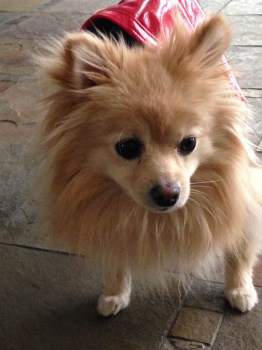

Bella, photo courtesy of The Weiss Family
The goal will be to exercise your Pom each day and maintain a healthy weight. Adult Poms only eat about 1/2 to 1 and 1/2 cup of food per day and this can seem like a super small amount to us humans who eat a heck of a lot more.
Again, you'll want to focus on keeping your Pom active and feeding wholesome foods and not be worried about exact calorie count.
Seniors
- It's very hard to admit when a dog must be classified as a senior; however this breed is often still quite active and happy in their 'old age'.
Seniors still need to be walked and played with, though they do need slightly less calories per day to maintain.
If your Pom has a hearty appetite, one effective method of allowing the dog to still eat the same amount but with fewer calories, is to swap out a bit of the higher calorie foods for lower calorie ingredients. Adding in some fresh green beans, baby peas and fruit
is a healthy way to accomplish this.
Other Pages of Interest:
My Pomeranian keeps eating grass - How to stop a Pom from this common, but unhealthy, habit that can lead to tummy upset and even contraction of worms.
The Oldest Living Pomeranian
- We've started documenting the oldest Poms on record. You may be surprised to see the age of this Pom and just how cute he is.
Advice to Stop a Pomeranian From Barking
- If your Pom is barking up a storm, there are things you can do to stop this.
You May Also Like:
Helping a Pomeranian with Separation Anxiety
- It's an awful feeling to leave the house knowing that your Pom struggles when he's home along. Great methods regarding how to help.
The Best Supplies for a Pomeranian
- A list of everything you should have to take optimal care of your Pom.
If you email photos to us, you agree that PetPom is given free copyright to use at our discretion. We will always credit the photo to the name of the Pom's owner(s) if it is supplied.
Email: Contact@PetPom.com
All text, images and artwork protected by US and International copyright laws. All rights reserved. Copyright PetPom.com
We are a participant in the Amazon Services LLC Associates Program, an affiliate advertising program designed to provide a means for us to earn fees by linking to Amazon.com and affiliated sites.

